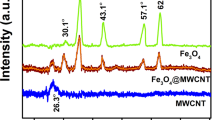Abstract
Nanoflowers (NFs) are flower-like nanoparticles showing morphological similarity to flower petal in microscopic view between the range of 100–500 nm. NFs show better adsorption efficiency due to high surface-to-volume ratio depending on the morphology and particle size. The objective of the present research work was to prepare adsorbent NFs and to evaluate their adsorption efficiency in comparison with activated charcoal for the removal of toxins. The study focused on NFs as potential adsorbent for the adsorption of chlorpyrifos. Magnetic nanoparticles were prepared using precipitation method, and adsorbent NFs were prepared using ionotropic gelation method. The prepared magnetic nanoparticles and adsorbent NFs were characterized using particle size, zeta potential, surface morphology, attenuated total reflection-Fourier transform infrared (ATR-FTIR) spectroscopy, differential scanning calorimetry, thermal behavior, nuclear magnetic resonance, and in vitro adsorption studies. The particle size and zeta potential of iron oxide nanoparticles were found to be 148.9 ± 1.36 nm and 8.93 ± 1.26 mV, and those of adsorbent NFs were 663.7 ± 39.63 nm and − 12.36 ± 1.05 mV, respectively. Transmission electron microscopy images confirmed spherical shape of iron oxide nanoparticles and flower-like shape of adsorbent NFs. ATR-FTIR analysis confirmed the formation of iron oxide nanoparticles and adsorbent NFs. The adsorption of chlorpyrifos using NFs was maximum at pH 7 with the magnetic effect of 517 kOe. Comparative studies showed that NFs (20 mg) possess larger adsorption efficiency of 37.65 ± 0.28% than activated charcoal (400 mg) which showed 31.64 ± 0.44% adsorption for the removal of chlorpyrifos. Adsorbent NFs are a novel nanoformulation for better removal of toxins due to larger surface area and improved adsorption efficacy.
Graphical abstract












Similar content being viewed by others

References
Alavanja MCR (2011) Introduction: pesticides use and exposure, extensive worldwide. Rev Environ Health 24:303–310. https://doi.org/10.1515/reveh.2009.24.4.303
Colovic MB, Krstic DZ, Lazarevic-Pasti TD, Bondzic AM, Vasic VM (2013) Acetylcholinesterase inhibitors: pharmacology and toxicology. Curr Neuropharmacol 11:315–335. https://doi.org/10.2174/1570159x11311030006
Elliott C (2004) Methods for adsorption and retention of solvated compounds and ions Patent no:
Giri TK, Thakur A, Alexander A, Badwaik AH, Tripathi DK (2012) Modified chitosan hydrogels as drug delivery and tissue engineering systems: Present status and applications. Acta Pharm Sin B 2:439–449. https://doi.org/10.1016/j.apsb.2012.07.004
Gour A, Jain NK (2019) Advances in green synthesis of nanoparticles. Artif Cells Nanomed Biotechnol 47:844–851. https://doi.org/10.1080/21691401.2019.1577878
Hashad RA, Ishak RAH, Fahmy S, Mansour S, Geneidi AS (2016) Chitosan-tripolyphosphate nanoparticles: optimization of formulation parameters for improving process yield at a novel pH using artificial neural networks. Int J Biol Macromol 86:50–58. https://doi.org/10.1016/j.ijbiomac.2016.01.042
Horsak RD, Bedient PB, Hamilton MC, Ben TF (2005)
Huang J, Cao Y, Liu Z, Deng Z, Tang F, Wang W (2012) Efficient removal of heavy metal ions from water system by titanate nanoflowers. Chem Eng J 180:75–80. https://doi.org/10.1016/j.cej.2011.11.005
Kaur S, Rani S, Mahajan R (2013) Adsorption kinetics for the removal of hazardous dye Congo Red by biowaste materials as adsorbents. J Chem 2013:628582. https://doi.org/10.1155/2013/628582
Kharisov B (2008) A review for synthesis of nanoflowers. Recent Pat Nanotechnol 2:190–200. https://doi.org/10.2174/187221008786369651
Kim KH, Kabir E, Jahan SA (2017) Exposure to pesticides and the associated human health effects. Sci Total Environ 575:525–535. https://doi.org/10.1016/j.scitotenv.2016.09.009
Lassoued A, Lassoued MS, Dkhil B, Ammar S, Gadri A (2018) Synthesis, structural, morphological, optical and magnetic characterization of iron oxide (α-Fe2O3) nanoparticles by precipitation method: effect of varying the nature of precursor. Phys E Low Dimen Syst Nanostruct 97:328–334. https://doi.org/10.1016/j.physe.2017.12.004
Mostafalou S, Abdollahi M (2017) Pesticides: an update of human exposure and toxicity. Arch Toxicol 91:549–599. https://doi.org/10.1007/s00204-016-1849-x
Negahdary M, Heli H (2018) Recent patents on nanotechnology. Appl Nanoflowers Biomed. https://doi.org/10.2174/1872210511666170911153428
Oubagaranadin JUK, Sathyamurthy N, Murthy ZVP (2007) Evaluation of Fuller’s earth for the adsorption of mercury from aqueous solutions: a comparative study with activated carbon. J Hazard Mater 142:165–174. https://doi.org/10.1016/j.jhazmat.2006.08.001
Pishgar F, Ahmad Panahi H, Khodaparast Haghi AA, Motaghitalab V, Hasani AH (2016) Comparative study on adsorptive characteristics of diazinon and chlorpyrifos from water by thermosensitive nanosphere polymer. J Chem. https://doi.org/10.1155/2016/8329650
Qiao R, Yang C, Gao M (2009) Superparamagnetic iron oxide nanoparticles: from preparations to in vivo MRI applications. J Mater Chem 19:6274–6293. https://doi.org/10.1039/b902394a
Sánchez-Santed F, Colomina MT, Herrero Hernández E (2016) Organophosphate pesticide exposure and neurodegeneration. Cortex 74:417–426. https://doi.org/10.1016/j.cortex.2015.10.003
Shende P, Sahu P (2021) Enzyme bioconjugated PAMAM dendrimers for estimation of glucose in saliva. Int J Polym Mater Polym Biomater 70:469–475. https://doi.org/10.1080/00914037.2020.1725762
Shende P, Kasture P, Gaud RS (2018) Nanoflowers: the future trend of nanotechnology for multi-applications. Artif Cells Nanomed Biotechnol 46:413–422. https://doi.org/10.1080/21691401.2018.1428812
Singh J, Dutta T, Kim KH, Rawat M, Samddar P, Kumar P (2018) “Green” synthesis of metals and their oxide nanoparticles: Applications for environmental remediation. J Nanobiotechnol 16:1–24. https://doi.org/10.1186/s12951-018-0408-4
Takke A, Shende P (2021) Monodispersed magnetographene quantum dot nanocomposites for delivery of silibinin. Colloids Surf A Physicochem Eng 628:127349. https://doi.org/10.1016/j.colsurfa.2021.127349
Unsoy G, Yalcin S, Khodadust R, Gunduz G, Gunduz U (2012) Synthesis optimization and characterization of chitosancoated iron oxide nanoparticles produced for biomedical applications. J Nanopart Res. https://doi.org/10.1007/s11051-012-0964-8
Wang B, Wei Q, Qu S (2013) Synthesis and characterization of uniform and crystalline magnetite nanoparticles via oxidation-precipitation and modified co-precipitation methods. Int J Electrochem Sci 8:3786–3793
Wang X, Shi J, Li Z, Zhang S, Wu H, Jiang Z, Yang C, Tian C (2014) Facile one-pot preparation of chitosan/calcium pyrophosphate hybrid microflowers. ACS Appl Mater Interfaces 6:14522–14532. https://doi.org/10.1021/am503787h
Wen Wang J, Hsiung Hon M (2005) Template mediated nanofibrous structure. Novel chitosan/polyethylene glycol scaffold for tissue engineering. Recent Adv Multidiscip Appl Phys. https://doi.org/10.1016/B978-008044648-6.50053-7
Funding
Not applicable.
Author information
Authors and Affiliations
Corresponding author
Ethics declarations
Conflict of interest
All authors declare that they have no conflict of interest.
Additional information
Publisher's Note
Springer Nature remains neutral with regard to jurisdictional claims in published maps and institutional affiliations.
Rights and permissions
About this article
Cite this article
Devlekar, N.P., Shende, P. Green synthesis of adsorbent nanoflowers for efficient removal of toxins. Chem. Pap. 76, 2209–2219 (2022). https://doi.org/10.1007/s11696-021-02020-z
Received:
Accepted:
Published:
Issue Date:
DOI: https://doi.org/10.1007/s11696-021-02020-z



